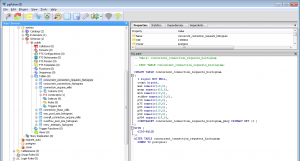How to import CSV data into PostgreSQL
Introduction
Many database servers support CSV data transfers and this post will show one way you can import CSV files to PostgreSQL.
SQL aggregation rocks!
My previous post demonstrated FlexyPool metrics capabilities and all connection related statistics were exported in CSV format.
When it comes to aggregation tabular data SQL is at its best. If your database engine supports SQL:2003 windows functions you should definitely make use of this great feature.
Scripting flavors
For scripting I mostly rely on Python or Bash scripting. Python is powerful and expressive while Bash scripting doesn’t need too many dependencies, even on Windows.
Scripting time
These are the CSV files to be imported :
$ ls -1 *.csv concurrentConnectionRequestsHistogram.csv concurrentConnectionsHistogram.csv connectionAcquireMillis.csv connectionLeaseMillis.csv maxPoolSizeHistogram.csv overallConnectionAcquireMillis.csv overflowPoolSizeHistogram.csv retryAttemptsHistogram.csv
All these files are Codahale histogram and timer metrics and this is how the import script looks like:
#!/bin/bash
function import_histogram(){
echo "Importing Histogram file: $2 to $1 table"
psql metrics postgres <<SQL
CREATE TABLE IF NOT EXISTS $1 (
t BIGINT,
count BIGINT,
max NUMERIC(19, 6),
mean NUMERIC(19, 6),
min NUMERIC(19, 6),
stddev NUMERIC(19, 6),
p50 NUMERIC(19, 6),
p75 NUMERIC(19, 6),
p95 NUMERIC(19, 6),
p98 NUMERIC(19, 6),
p99 NUMERIC(19, 6),
p999 NUMERIC(19, 6),
PRIMARY KEY (t)
);
COPY $1(
t,
count,
max,
mean,
min,
stddev,
p50,
p75,
p95,
p98,
p99,
p999
)
FROM '$2' WITH DELIMITER ',' CSV HEADER;
SQL
}
function import_timer(){
echo "Importing Timer file: $2 to $1 table"
psql metrics postgres <<SQL
CREATE TABLE IF NOT EXISTS $1 (
t BIGINT,
count BIGINT,
max NUMERIC(19, 6),
mean NUMERIC(19, 6),
min NUMERIC(19, 6),
stddev NUMERIC(19, 6),
p50 NUMERIC(19, 6),
p75 NUMERIC(19, 6),
p95 NUMERIC(19, 6),
p98 NUMERIC(19, 6),
p99 NUMERIC(19, 6),
p999 NUMERIC(19, 6),
mean_rate NUMERIC(19, 6),
m1_rate NUMERIC(19, 6),
m5_rate NUMERIC(19, 6),
m15_rate NUMERIC(19, 6),
rate_unit VARCHAR(64),
duration_unit VARCHAR(64),
PRIMARY KEY (t)
);
COPY $1(
t,
count,
max,
mean,
min,
stddev,
p50,
p75,
p95,
p98,
p99,
p999,
mean_rate,
m1_rate,
m5_rate,
m15_rate,
rate_unit,
duration_unit
)
FROM '$2' WITH DELIMITER ',' CSV HEADER;
SQL
}
for csv_file in *.csv
do
table_name=`echo ${csv_file%%.*}|sed -e 's/\([A-Z]\)/_\L\1/g'`
csv_folder_path="$(cygpath -w `pwd`)"
csv_file_path=$csv_folder_path/$csv_file
if [[ $table_name == *histogram ]]
then
import_histogram $table_name $csv_file_path
elif [[ $table_name == *millis ]]
then
import_timer $table_name $csv_file_path
fi
doneBecause PostgreSQL requires Windows paths we need to use the $(cygpath -w `pwd`) command to translate the Cygwin like paths to their Windows equivalent.
Let’s run this scrip now:
vlad@HOME /cygdrive/d/metrics $ dos2unix codahale_metrics_csv_to_postgres.sh dos2unix: converting file codahale_metrics_csv_to_postgres.sh to Unix format ... vlad@HOME /cygdrive/d/metrics $ ./codahale_metrics_csv_to_postgres.sh Importing Histogram file: D:\metrics/concurrentConnectionRequestsHistogram.csv to concurrent_connection_requests_histogram table NOTICE: CREATE TABLE / PRIMARY KEY will create implicit index "concurrent_connection_requests_histogram_pkey" for table "concurrent_connection_requests_histogram" CREATE TABLE COPY 1537 Importing Histogram file: D:\metrics/concurrentConnectionsHistogram.csv to concurrent_connections_histogram table NOTICE: CREATE TABLE / PRIMARY KEY will create implicit index "concurrent_connections_histogram_pkey" for table "concurrent_connections_histogram" CREATE TABLE COPY 1537 Importing Timer file: D:\metrics/connectionAcquireMillis.csv to connection_acquire_millis table NOTICE: CREATE TABLE / PRIMARY KEY will create implicit index "connection_acquire_millis_pkey" for table "connection_acquire_millis" CREATE TABLE COPY 1537 Importing Timer file: D:\metrics/connectionLeaseMillis.csv to connection_lease_millis table NOTICE: CREATE TABLE / PRIMARY KEY will create implicit index "connection_lease_millis_pkey" for table "connection_lease_millis" CREATE TABLE COPY 1537 Importing Histogram file: D:\metrics/maxPoolSizeHistogram.csv to max_pool_size_histogram table NOTICE: CREATE TABLE / PRIMARY KEY will create implicit index "max_pool_size_histogram_pkey" for table "max_pool_size_histogram" CREATE TABLE COPY 1537 Importing Timer file: D:\metrics/overallConnectionAcquireMillis.csv to overall_connection_acquire_millis table NOTICE: CREATE TABLE / PRIMARY KEY will create implicit index "overall_connection_acquire_millis_pkey" for table "overall_connection_acquire_millis" CREATE TABLE COPY 1537 Importing Histogram file: D:\metrics/overflowPoolSizeHistogram.csv to overflow_pool_size_histogram table NOTICE: CREATE TABLE / PRIMARY KEY will create implicit index "overflow_pool_size_histogram_pkey" for table "overflow_pool_size_histogram" CREATE TABLE COPY 1537 Importing Histogram file: D:\metrics/retryAttemptsHistogram.csv to retry_attempts_histogram table NOTICE: CREATE TABLE / PRIMARY KEY will create implicit index "retry_attempts_histogram_pkey" for table "retry_attempts_histogram" CREATE TABLE COPY 1537
After running this script we got the following fully-loaded PostgreSQL tables:
My next post will put window functions to work, as I want to compare the FLexyPool empirical metrics to the queueing theory probabilities.
| Reference: | How to import CSV data into PostgreSQL from our JCG partner Vlad Mihalcea at the Vlad Mihalcea’s Blog blog. |





